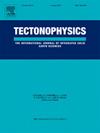The complex 4D multi-segmented rupture of the 2014 Mw 6.2 Northern Nagano Earthquake revealed by high-precision aftershock locations
IF 2.7
3区 地球科学
Q2 GEOCHEMISTRY & GEOPHYSICS
引用次数: 0
Abstract
Enhanced earthquake sequence seismic catalogs have the potential to reveal fault surface complexities at depth (e.g., segmentation, bends). Past analyses were generally restricted to 2D analysis considering faults discontinuous along their strike and do not include segment temporal evolution. Our work provides a comprehensive methodology, for reconstructing the 3D fine-scale (few kilometers length) geometry of a segmented fault surface and to characterize the triggering of the segments during an earthquake mainshock-aftershock sequence We analyzed the 2014 Northern Nagano (Japan) (Mw 6.2) earthquake sequence using high-resolution seismic catalogs. We automatically detected and located about 2500 events between October and December 2014 with a magnitude range between –0.6 and 6.2. We refined the automatic picks, based on cross-correlation and hierarchical clustering, and we relocated the hypocenters with the double-difference technique in 3D velocity models optimized for the area. Moreover, we calculated the composite focal mechanisms of the main clusters, crucial to constrain the kinematics and the 3D geometry of the fault segments, and rupture directivity that we interpreted jointly with the seismicity and the fault slip. We find that a segmented fault surface comprising, at least, 9 distinct segments, ruptured during 3 successive activation phases. The different segments exhibit a different rupture mechanism based on their spatial and temporal occurrence, influencing seismicity evolution and rupture length. Our method, based on deep analysis of relocated aftershocks sequence, can be used in other study cases for the fault surface reconstruction to better understand the complexity of the earthquake rupture.
2014年Mw 6.2北长野地震高精度余震定位揭示的复杂四维多段断裂
增强的地震序列地震目录有可能揭示断层表面在深度上的复杂性(例如,分段、弯曲)。过去的分析一般局限于二维分析,考虑断层沿其走向不连续,不包括分段的时间演化。我们的工作提供了一种全面的方法,用于重建分段断层面的三维精细(几公里长)几何形状,并表征地震主震-余震序列中分段的触发。我们使用高分辨率地震目录分析了2014年日本长野北部(Mw 6.2)地震序列。在2014年10月至12月期间,我们自动检测并定位了大约2500个震级在-0.6到6.2之间的地震事件。我们在相互关联和分层聚类的基础上改进了自动选择,并在针对该地区优化的3D速度模型中使用双差技术重新定位震源。此外,我们还计算了主要震群的复合震源机制,这对约束断层段的运动学和三维几何形状至关重要,以及我们将地震活动性和断层滑动联合解释的破裂指向性。我们发现,在连续的3个活动阶段中,一个分段的断层面至少包含9个不同的分段。不同的断裂带根据其时空分布表现出不同的破裂机制,影响地震活动性演化和破裂长度。该方法基于对重新定位余震序列的深入分析,可用于断层面重建的其他研究案例,以更好地了解地震破裂的复杂性。
本文章由计算机程序翻译,如有差异,请以英文原文为准。
求助全文
约1分钟内获得全文
求助全文
来源期刊

Tectonophysics
地学-地球化学与地球物理
CiteScore
4.90
自引率
6.90%
发文量
300
审稿时长
6 months
期刊介绍:
The prime focus of Tectonophysics will be high-impact original research and reviews in the fields of kinematics, structure, composition, and dynamics of the solid arth at all scales. Tectonophysics particularly encourages submission of papers based on the integration of a multitude of geophysical, geological, geochemical, geodynamic, and geotectonic methods
 求助内容:
求助内容: 应助结果提醒方式:
应助结果提醒方式:


